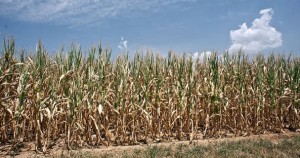Biologist On The Midwestern Drought: 'It's Like Farming In Hell'
 As intense heat and drought conditions continue across much of the Midwest, they are starting to take a toll on crop yields. According to a university plant biologist, operating in such conditions is “like farming in hell.”
As intense heat and drought conditions continue across much of the Midwest, they are starting to take a toll on crop yields. According to a university plant biologist, operating in such conditions is “like farming in hell.”The U.S. corn crop, which is the largest in the world, is at a very vulnerable point in its development: the pollination phase. Although the harvest isn’t for two months, future yields will be determined in the next few weeks as crops pollinate. However, the unusually hot and dry conditions are complicating this phase.
Bloomberg Businessweek reported on how drought conditions are impacting corn farmers:
“This is a very narrow window for corn, and there’s little room for error,” said Brad Rippey, an agricultural meteorologist for the United States Department of Agriculture. “Whatever happens in that window, it is what it is — that cob is made or broken.”
“Corn yields were falling five bushels a day during the past week” in the driest parts of the Midwest, said Fred Below, a plant biologist at the University of Illinois in Urbana. “You couldn’t choreograph worse weather conditions for pollination. It’s like farming in hell.”
Despite earlier predictions of a record yield, revised forecasts are anticipating crop losses not seen since the drought of 1988.
The Midwestern drought now encompasses portions of five corn producing states, including almost all of Ohio. “‘It all quickly went from ideal to tragic,’ said Don Duvall, a farmer in Illinois who, in what was a virtually rainless June, has watched two of his cornfields dry up and die as others remain in some uncertain in-between.”
The drought, which has kept rainfall levels in Columbus, Ohio at half of their normal levels, has been exacerbated by an intense heat wave that set over 4,000 high-temperature records in the last 30 days. In corn country, temperatures in places like Jefferson County, Mississippi, reached as high as 111.
Coupled with the heat and lack of rainfall is low soil moisture levels. Measurements taken in Illinois, Indiana, Ohio, Missouri and Kentucky recorded soil moisture levels “in the 10th percentile among all other years since 1895.”
“The drought is much worse than last year and approaching the 1988 disaster,” said John Cory, the chief executive officer of Rochester, Indiana-based grain processor Prairie Mills Products LLC. “There are crops that won’t make it. The dairy and livestock industries are going to get hit very hard. People are just beginning to realize the depth of the problem.”
As this latest drought unfolds, researchers are looking at the impact of climate change on the intensity and likelihood of such an event. As Texas Climatologist Katherine Kayhoe recently told Climate Progress, extra energy in the atmosphere from greenhouse gases are creating new “background conditions”:
We often try to pigeonhole an event, such as a drought, storm, or heatwave into one category: either human or natural, but not both. What we have to realise is that our natural variability is now occurring on top of, and interacting with, background conditions that have already been altered by long-term climate change.
As our atmosphere becomes warmer, it can hold more water vapor. Atmospheric circulation patterns shift, bringing more rain to some places and less to others. For example, when a storm comes, in many cases there is more water available in the atmosphere and rainfall is heavier. When a drought comes, often temperatures are already higher than they would have been 50 years ago and so the effects of the drought are magnified by higher evaporation rates.
As Joe Romm pointed out on Sunday, the Earth has warmed only a bit more than 1 degree Fahrenheit since the catastrophic Dust Bowl — and the world is set to warm by between 9-11°F this century if we stay on a business-as-usual emissions path. That would make a lot more of America a true “hell” for farmers.
You can return to the main Market News page, or press the Back button on your browser.

